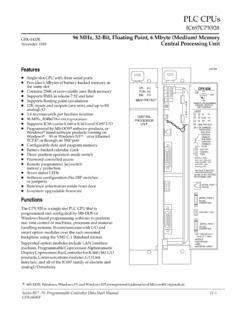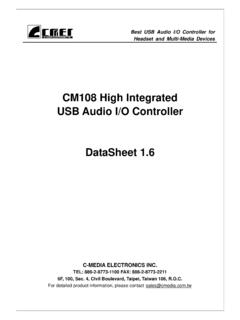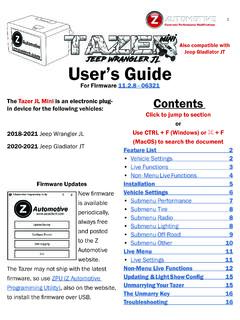Transcription of General Motors Computerized Vehicle Control Systems: A ...
1 Tom Boynton CET 249 December 2006 General Motors Computerized Vehicle Control Systems: A Short History 2 The modern automobile has progressed greatly in the last 100 years. Just as our everyday consumer life has become sophisticated, our transportation has followed suit. Just how complex the modern automobile has beco me, though, is most likely not known by the average person. We see all the high tech gadgets nowadays, high speed internet, high speed computers and fancy entertainment systems, these concepts are all in the modern car. This paper will explain a few details of our modern automotive computer systems. To understand the need for automotive networks, a short explanation of a cars electrical system is necessary. The earliest vehicles started out with some primitive Control systems. The ignition coil for firing the fuel charge in the internal combustion engine was clocked by the ignition points and timed to the engines firing order.
2 It was a basic mechanical system and was not always the most efficient as it relied on a mechanical devices to provide timing which followed a set curve and had moving parts to wear out. Numerous moving contact type controls for different parts of vehicles tended to fail or wear out quickly due to the harsh conditions present in cars such as heat, cold and continuous vibrations. Modern solid state Control systems started to appear in the early seventies as transistor technology and cheaper solid state products entered the market. The transistor provided an excellent way to incorporate things such as the ignition s mechanical points into electronic ignition modules which didn t require maintenance, were much more reliable and could be produced cheaply. Other things that helped bring about a change in automobile management systems was the need to more precisely Control a Vehicle s engine systems so as to keep up with increasing emissions and fuel economy standards.
3 In the early sixties, with automobile production soaring and Eisenhower s new federal highway system making automobile travel much easier, people started to realize that the Earth s atmosphere was getting increasingly polluted from the noxious fumes that were belching out of the automotive jungle. Large cities such as Los Angeles and New York City were developing large smog problems and there was some need to improve the amount of pollution entering our atmosphere. The Clean Air Act in 1967 started a trend in controlling our vehicles very precisely to clean up our urban areas. The first Clean Air Act only did very minimal things such as requiring the crankcase gases to be a closed system and nitrous oxides emissions to be reduced with an 3 EGR system . The really big change came in 1980 with the initiation of the revised 1977 version of the Clean Air Act which set some higher emissions standards, outlawed leaded gasoline, introduced the catalytic converters as mandatory equipment and required vehicles to monitor their emissions controls with a light on the dashboard called the check engine light.
4 This was the real start, the check engine light. All vehicles sold in the US were required to have a monitoring system which would turn on this lamp if there were an electrical failure of any emissions related component and vehicles would need to be able to display a failure code which would tell the repairer which system was the culprit. Of course with the stricter emissions standards, the manufacturers would need to switch over to modern fuel injection anyway (as it was way more efficient) and Computerized controls were necessary to Control this injection. General Motors was the forerunner in Computerized technologies with the other two domestic car manufacturers only meeting the bare minimum to abide with the new regulations. So the modern story really begins in 1980 with a check engine light and a primitive computer in every Vehicle . These computers were pretty primitive all right, big tin boxes with edge-board connectors which had a tendency to oxidize and cause drivability problems.
5 I remember well removing the computer connectors on early 1980 s Cadillac models and rubbing the edge-board connectors with a pencil eraser. This would clean the oxidation on the circuit board traces and restore a poorly conducting circuit. The early automotive computers also had mechanical devices in them such as vacuum sensors which would require a small vacuum hose to enter the computer s external case which affected case integrity. Eventually someone got the right idea to put the vacuum sensor external in the engine compartment with sealed wires with weatherproof terminals entering the computer cases. We used to have what s called the tap-test which was just what it sounded like; you tapped lightly on the computer of a Vehicle with a strange engine problem. If tapping on the computer caused the car to react, the computer was failing. This was quite common in the eighties and early nineties until a more robust case and circuit board was designed in 1996 with the advent of more stringent emissions laws.
6 The new circuit boards had a coating on them to resist corrosion of the solder joints due to vibration and the new cases were made of cast aluminum and sealed much better. 4 This is a modern computer case. You can see the case is much thicker than the old case below it. The small access cover on the top is for the electronic spark Control (knock sensor) module which is remo vable. The removable PROM is now an EEPROM and is hard soldered to the circuit board. This is the old style thin sheet metal case. The removable panel in the back was for the PROM which could be changed. The first beginnings of automotive networks began in the Cadillac and Oldsmobile models of the early eighties with the advent of a second computer other than the central engine Control module. This new computer had a microprocessor and was called the BCM (Body Control Module). The engine Control module (ECM) would Control all engine functions while the BCM controlled items such as automatic lighting, HVAC (heating and air conditioning) controls and alarm and lock functions.
7 The BCM came about as consumer demands and competition led to newer creature comforts in the modern automobile. GM needed to get a method to tie these two computers together. The ECM and BCM would communicate such things as engine temperature and Vehicle run time info with each other through a protocol called UART (universal asynchronous receiver transmitter). Communications on a single wire reduced redundant 5wiring greatly with sensors just wired to one module. This UART was a binary language with the on or off values controlled by a zero volt or 5 volt signal that varied in pulse width. One of my training manuals from 1986 on Cadillac Allante BCM electronics describes the operation of UART. With the system resting at 5 volts, the BCM, which controlled bus timing and traffic, pulses out an address code. All the modules see this code as in Ethernet protocol but only the module with that particular code can respond to the message. All modules can listen in and decode any messages, though, so they can read certain info such as engine coolant temp data which is on the bus often.
8 A module isn t allowed to respond unless it is addressed directly by the BCM. The BCM can t send any other messages until it has first finished the conversation it was just having. The receiving device will pull the system high so it is declared idle, then it will respond by sending its own address code, then it sends its data. It will then hold the system high so it is once again declared idle. The BCM will then be allowed to continue talking. 6 1986 Cadillac Allante Network, circuit 800, UART line - The ALDL is the diagnostic connector. A few years later the digital instrument panel cluster (IPC) received another microprocessor which communicated with the other two modules on the UART dedicated serial data line. This was a single circuit that was referenced to ground and was shared to a certain pin on each module. To prevent collisions of data and to establish a communications protocol, one of the modules would be designated the Master of the Bus , which meant it had the duty of checking with all of the modules and assigning transmission timing so as to facilitate a functional network on the serial data bus as it was now called.
9 At one point the Cadillac models received a new module under the dash called the Central Power Supply which acted as a universal power supply to isolate the various microprocessor modules from the rest of the automotive power system which could have damaging spikes and variations in voltage. One-by-one more modules 7appeared such as the Fan Control Module (to precisely Control the engine cooling fan), the Remote Keyless Entry Module which received the microwaves from a Vehicle remote to unlock doors and send an alarm off signal to the BCM. The fancy Oldsmobile Cutlass Trofeo had a CRT touch screen display in the dash which added to the UART bus. An Electronic Brake Control Module appeared in the mid-eighties to higher end cars which controlled all the functions of the anti-lock brake system . This EBCM needed engine run and Vehicle sensor information from the other modules and found this out by being wired to the UART bus. Add a suspension Control module to the mix, an airbag system module (SDM), etc and the network got busier and busier as time went on.
10 The main engine Control computers went through a series of changes throughout the years. The early ones were called the ECM short for engine Control module. This just controlled the engine system . As this main computer started to Control the new electronically controlled automatic transmissions its designation changed to a PCM or powertrain Control module. Some main computers controlled the transmission, the engine and the ABS; these were called the VCM s or Vehicle Control module. As automatic transmissions became more complex, some systems started to separate the PCM back into the ECM and a separate TCM or transmission Control module. This was possible as networking systems had become more complex to allow integration of the one into two. As in internet and business networking the acronym list began to grow! The earliest systems had a baud rate of around 1,024 bits per second and considering the little amount of data that was being processed, that was OK.






